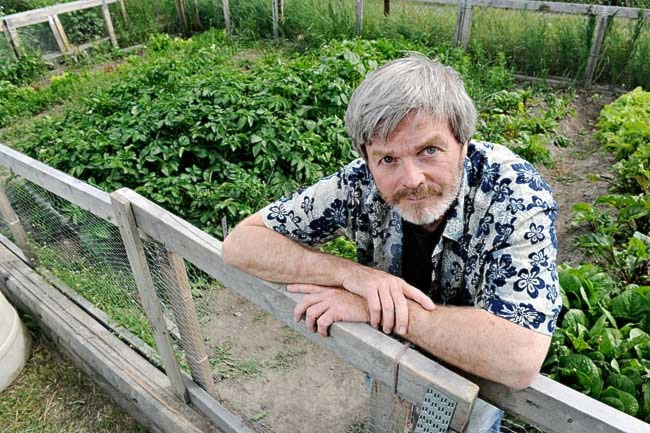If you don’t know what humic acid is, you probably haven’t met Chris Webb.
An avid gardener, Webb has been selling the “bio-catalyst” in the Yukon for over a year now.
He’s a relentless promoter of the natural fertilizer. Once you get him talking about it, it’s almost impossible to make him stop.
“The only way you’re safe is if you say that you don’t have a garden,” he said.
Produced from decaying plant matter, and often found near soft coal deposits, humic acid is actually a complex mixture of many different acids.
Humic substances are some of the fundamental organic elements of soil.
“The stuff is what makes dirt soil,” he said. “If you don’t have any humus in your soil, it’s just dirt, and nothing will grow.”
Webb got into the business after a friend, Raymond Potie, started mining it in Saskatchewan.
When Webb moved to the Yukon two years ago, he asked Potie to send him a bucket of the stuff to use on his plot in the Whitehorse community garden.
With more than he could use himself, Webb started to share his supply with others.
It didn’t take long before it started to catch on, and Webb became the exclusive northern distributor for Potie’s company, Wapaw Bay Resources.
Almost everyone saw noticeable results, said Webb. Everything from Kale to apple trees saw dramatic improvements in growth and yield.
Back then, these anecdotal results were enough for Webb. But now he wants to prove it out scientifically.
A chance meeting with a researcher from Yukon College gave him that opportunity.
Last year, Webb, who was volunteering for Arts in the Park, went to pick up pizzas for the event, but the order got mixed up.
It was a lucky mistake.
While he was waiting for the pizza dealer to sort it out, Webb struck up a conversation with another customer in line.
It just so happened that Ken Nordin, a senior technologist for LaBerge Environmental Services, was conducting research on mine reclamation at Yukon College.
When Webb started preaching the virtues of humic acid, it piqued Nordin’s interest.
“Next thing I know, they wanted half a ton for research,” said Webb.
They also hired Webb as a lab assistant for the project.
“It’s super neat to be involved, because I never would have thought I’d be on the forefront of research.”
Nordin is investigating the use of biochar to grow plants near old mine sites.
Biochar is produced by burning organic matter in the absence of oxygen. Basically it’s charcoal.
It’s been used for thousands of years to enrich soils.
“The angle we’re working on is to see if it’s effective in mine reclamation,” said Nordin.
Even at the best of times, the soil in the Yukon is generally of pretty poor quality. And former mine sites are even worse.
“They’re stripped right down to mineral soils and have got nothing going for them whatsoever,” said Nordin.
That’s where the biochar comes in.
In the same way that a wet sponge left on the kitchen counter will quickly become overtaken by mildew, when biochar is buried in the soil, its thousands of tiny pores creates massive surface area. That helps retain water and provides shelter for essential microbes.
Now Nordin, and the research team at Yukon College, are adding humic acid to some of their test plots to see if it will help plants take root.
“Humic acid has many similar attributes to biochar,” said Nordin.
Like biochar, humic acid also helps plants retain water and contributes the uptake of nutrients.
But just how humic acid does this is still poorly understood, but not for lack of effort.
Since it was first identified in the 1700s, there has been a massive amount of scientific investigation into the properties of humic acid. However, because the molecules are large and complex, and the quality of humic acid can vary widely, it’s a difficult thing for scientists to figure out.
As with many life processes, science really doesn’t understand what’s going on, said Garrett Gillespie, a soil engineer who runs the Whitehorse compost facility.
“In the place where I did my master’s degree, they had one of the biggest soil dynamic libraries in perhaps the world,” he said.
The library’s section on humus was about 20 metres long and 10 metres wide. These shelves were entirely filled with volumes to do with humus.
“You always know when you’re reading a good book on humus, because the writer or research or whoever’s written it have somewhere, ideally on the first page, the statement that too little is understood about humus or how it works or just some kind of scientific wording to admit that we haven’t got a clue.”
While potential of using humic acid as a soil amendment to clean up mine sites is huge, Webb’s first passion is using it to grow food.
“Most people, when they garden, flood it and throw on tons of fertilizer, and most of it doesn’t stick around. It just takes off down the street or whatever,” he said.
But a little humic acid means a lot less water and fertilizer are needed.
“For farmers, that’s money in your pocket,” said Webb.
Contact Josh Kerr at
joshk@yukon-news.com
